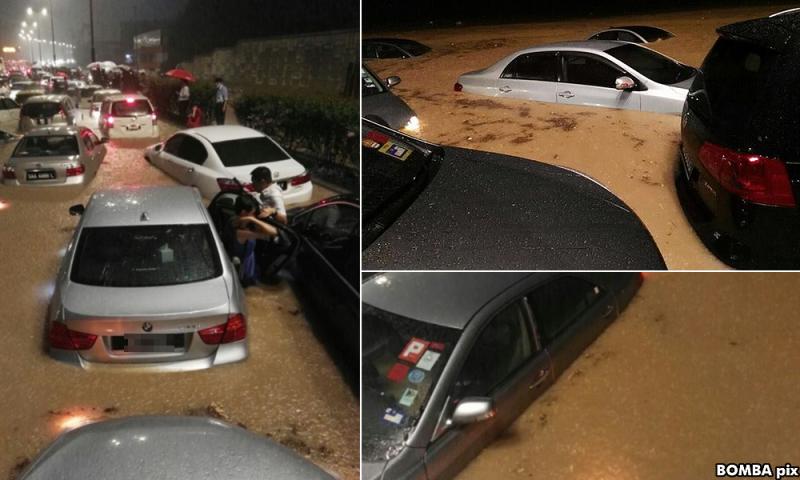Flash floods are the bane of urban areas in the Klang Valley, no thanks to the clogged drains that prevent excess water from being channelled into the rivers.
While the capital city has had its share of flash floods in the past, commuters heading back home after work on May 12 were taken by surprise when several key roads in Kuala Lumpur, including Jalan Pantai Baharu and Jalan Tuanku Abdul Halim, were submerged following a heavy downpour.
Some 100 vehicles were trapped along the road towards Damansara and Kuala Lumpur, forcing motorists to abandon their vehicles.
What measures can the Kuala Lumpur City Hall and other local authorities take to halt the occurrence of flash floods?
Poor drainage system
Head of Universiti Teknologi Mara’s Environmental Research Centre Prof Dr Ku Halim Ku Hamid said the main culprit behind flash floods was none other than the inefficient drainage system, complete with drains that were poorly maintained and almost always clogged.
Making the situation worse were public apathy and developers of mega projects who pay no heed to putting in place flood mitigation measures, he said.
Ku Halim said during the recent dry spell, a lot of dry leaves and twigs had fallen to the ground and ended up clogging the drains, causing the rainwater to overflow onto the roads when it rained heavily.
“The dry spell had been rather long and we were probably not aware that dry leaves and other wastes were ending up in the drains... the sediments and garbage clump together and prevent water from flowing smoothly in the drain,” he said, adding that he himself has seen some people spraying water onto dried twigs and leaves and letting them flow into the drain, instead of collecting them and disposing of them properly.
Low-lying areas were particularly susceptible to flash floods and the situation could be worsened if, besides clogged drains, there were also other objects like stones, concrete and buildings obstructing the flow of water, he told Bernama.
Find solutions
Ku Halim urged the authorities to initiate research and development (R&D) efforts that could yield short-term and long-term measures to prevent the occurrence of flash floods in the city.
He said since such floods were a yearly feature, the various local authorities should have known by now their strengths and weaknesses in handling flash floods.
“I see it as an attitude problem... they (authorities) become regretful and earnestly go around looking for the cause (of the flash floods) only when the flood occurs. Prior to that they don’t take any drastic action to mitigate the problem... it looks like they have not learnt anything from the previous experiences.
“I’ve observed a lot of weaknesses in our drainage system and they have to pay due attention to this and make the relevant changes. There must be proactive maintenance, and simulations and proper mapping of the flood-prone areas must be carried out as soon as possible,” he said.
Ku Halim also said that infrastructure developments, particularly those located in valleys and areas which experience frequent rainfall, often fail to take into consideration environmental concerns and the flow of rainwater in their designs.
“Developments are being carried out haphazardly without realising their impact (on the environment)... as if that’s not enough, the public is also dumping garbage, especially polystyrene, indiscriminately,” he said.
Serious problem
Meanwhile, senior lecturer at Universiti Malaya’s (UM) Department of Geography Prof Dr Azizan Abu Samah felt that the only way to halt the recurrence of flash floods was by constructing another tunnel similar to the Stormwater Management and Road Tunnel (Smart) in Kuala Lumpur.
“The existing tunnel (Smart) only helps prevent floods in certain parts of KL and not the entire city. Hence, the authorities should consider another tunnel similar to Smart to divert excess rainwater to water catchment areas or lakes... but then building a tunnel like that involves heavy expenditure,” he said.
Azizan, who is also UM’s National Antarctic Research Centre director, said the capital city’s drainage used to be quite extensive in the past but much of it has been covered to make way for road widening.
He said flash floods could occur in any area even after ordinary rainfall if its drains were badly maintained.
“When it rains, only 50 percent of the run-off is absorbed by the ground while the remaining flows into drains and rivers. But urbanisation has led to drains being paved with concrete, resulting in water accumulating on the surface... the problem is compounded in low-lying areas.
“So it’s obvious that the whole problem (of flash floods) is (due to poor) drainage. Some pavements have openings to allow the rainwater to flow into the drain below but these holes are usually very small. Having bigger openings will pose a danger (to passers-by) as the grilles that are placed over them usually end up being stolen. Hence, the authorities must look for other effective ways (to drain excess water),” he added.
- Bernama





